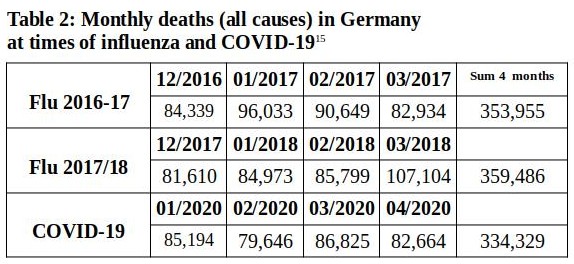"Everyone has the right to clear, accessible, timely and meaningful
information about the nature and extent of the threat to their
health".
(Esteban Beltrán, Director of Amnesty International's Spanish
Section, before the Economic and Social Reconstruction Commission of the
Spanish Parliament, European Union Group, 12 June 2020)
15: https://www.destatis.de/DE/Themen/Gesellschaft-Umwelt/Bevoelkerung/Sterbefaelle-Lebenserwartung/Tabellen/sonderauswertung-sterbefaelle.html?nn=209016,
accessed and downloaded 05/06/2020.
16: "When looking at the course of the year in the death statistics,
the typical fluctuations during the flu season from around
mid-December to mid-April should be noted. This becomes clear when
looking at the figures from previous years: In March 2019, for
example, around 86,400 people died; in March 2018, i.e. in a year when
the flu epidemic was particularly severe, the figure was 107,100. Even
without a Corona pandemic, the death figures can therefore fluctuate
greatly during the typical flu season. These fluctuations
particularly affect the number of deaths in the age group 65 and
older.
According to the preliminary death figures, the impact of the flu
wave in 2020 was very low compared to previous years. In January
2020, about 85.200 people died according to the preliminary count.
In February 2020, there were 79.600 deaths. Also in March 2020, with
a total of at least 86.800 deaths, no noticeable increase compared
to previous years is discernible when viewed on a month-by-month
basis. In April, however, with at least 82.600 cases, the number of
deaths was clearly above the average of previous years.
Looking at the trend by calendar week, there have been increased
death case numbers since the last week of March (23 to 29 March)
compared to the 2016 to 2019 average. This upward deviation was
greatest in the 15th calendar week (6 to 12 April). From the 16th
calendar week (13 to 19 April) onwards, the number of deaths fell
again significantly. In the 19th calendar week (4 to 10 May),
according to the preliminary count, the number of deaths was no
longer above the average of previous years. The findings on
temporary excess mortality, when looking at the absolute numbers,
are approximately in line with the data on confirmed COVID-19 deaths
reported to the Robert Koch Institute (RKI)." (https://www.destatis.de/DE/Themen/Gesellschaft-Umwelt/Bevoelkerung/Sterbefaelle-Lebenserwartung/sterbefallzahlen.html,
accessed 05/06/2020; translation and emphasis by R.W.)
17: https://www.destatis.de/DE/Presse/Pressemitteilungen/2020/06/PD20_203_12621.html?nn=209016,
accessed 06/05/2020.
Attempt to view in perspective the health hazard posed by the COVID-19 pandemic:
Mortality in spring of 2020 in Spain and Germany compared to the general death rate in both countries


1. Definition
of the problem and summary
1.1. Definition of the problem
1.2. Summary
4.
The usual "background" mortality patterns in Spain and Germany
compared to deaths with COVID-19
6. Personal follow-up comments in May 2021
Download
all pages in English as PDF

52 pages, 800 KB
I appreciate hints on errors and
suggestions for improvement:
r_a_wagner@gmx.de